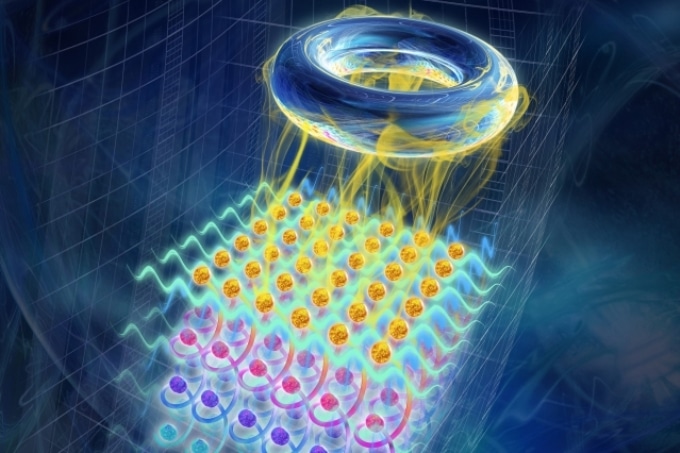May 30 2019
Senthil Todadri and Xiao-Gang Wen, professors at MIT, are members of the newly formed Simons Collaboration on Ultra-Quantum Matter.
 An artistic impression depicts ultra-quantum matter: from the cold topological matter (blue) to hot, strongly correlated metal (red). (Image credit: Harald Ritsch/University of Innsbruck)
An artistic impression depicts ultra-quantum matter: from the cold topological matter (blue) to hot, strongly correlated metal (red). (Image credit: Harald Ritsch/University of Innsbruck)
Supported by the Simons Foundation, the effort is an $8 million four-year award, renewable for three more years, and will aid theoretical physics research across 12 institutions, including MIT.
The science of the collaboration is dependent on a series of latest advancements in theoretical physics, showing that even large macroscopic systems comprising of several atoms or electrons—matter—can act in a typically quantum way. Ultra-quantum matter (UQM) such as this enables quantum phenomena beyond what can be achieved by individual atoms or electrons, such as fractional quantum numbers, distributed storage of quantum information, and perfect conducting boundary.
Although certain examples of UQM have been experimentally determined, much more have been theoretically hypothesized, ranging from highly entangled topological states to unconventional metals that act as a complex soup. The Simons Collaboration on Ultra-Quantum Matter will categorize probable forms of UQM, gain insights into their physical properties, and offer the key concepts to allow new realizations of UQM in the lab.
Ultra Dream Team
Specifically, the collaboration will draw upon conclusions from recently discovered connections between unconventional metals and topological states of matter, and attempts to create an innovative theoretical framework for those phases of ultra-quantum matter. Accomplishing these objectives necessitates concepts and tools from several areas of theoretical physics, and in this way, the collaboration gathers experts in quantum field theory, condensed matter physics, atomic physics, and quantum information to construct a new interdisciplinary strategy.
The collaboration is directed by Professor Ashvin Vishwanath at Harvard University and includes researchers from MIT, Harvard, Caltech, the Institute for Advanced Study, Stanford University, University of California at Santa Barbara, University of California at San Diego, University of Chicago, University of Colorado at Boulder, University of Innsbruck, University of Maryland, and University of Washington.
I am looking forward to scientific interactions with MIT theorists Senthil and Wen, who are key members of our Simons collaboration on Ultra-Quantum Matter, and hope this will further strengthen collaborations within the Cambridge area and beyond. Their research on highly entangled quantum materials is of fundamental significance, and may provide new directions for device applications, quantum computing, and high-temperature superconductors.
Ashvin Vishwanath, Director, Simons Collaboration on Ultra-Quantum Matter
“They have also been mentors for several collaboration members,” stated Vishwanath, who collaborated with Senthil as a Pappalardo Fellow in physics from 2001 to 2004.
Senthil has had a pioneering role to play in the area of non-Fermi liquids, in classifying strongly interacting topological insulators and associated topological phases, and in developing field theory dualities with varied applications in condensed matter physics.
Wen, who is one among the founders of the field of topological phases of matter, came up with the idea of topological order in 1989 and paved the way for a new research direction in condensed matter physics. Wen’s research has often revealed mathematical structures that have not been observed earlier in condensed matter physics problems.
MIT-Grown
Among the 17 faculty members participating in the collaboration, more than half, including Senthil, Wen, and Vishwanath, have MIT affiliations.
Michael Hermele, the collaboration’s deputy director and an associate professor at the University of Colorado at Boulder, was a postdoc in the MIT Condensed Matter Theory group.
Associate professors Xie Chen PhD ’12 and Michael Levin PhD ’06, at Caltech and the University of Chicago, respectively, earned their doctorates at MIT under Wen.
Other principal investigators of the study include alumni Subir Sachdev ’82, now chair of the Department of Physics at Harvard; and Leon Balents ’89, a physics professor at UC Santa Barbara’s Kavli Institute for Theoretical Physics. John McGreevy, a string theorist who performed studies in the Center for Theoretical Physics (CTP), is now a professor of physics at UC San Diego. Dam Thanh Son and Andreas Karch, former CTP postdocs, are now with the University of Chicago and the University of Washington, respectively.
The collaboration is part of the Simons Collaborations in Mathematics and Physical Sciences program, the objective of which is to “stimulate progress on fundamental scientific questions of major importance in mathematics, theoretical physics and theoretical computer science.” The Simons Collaboration on Ultra-Quantum Matter is one of 12 such collaborative grants ranging across these fields.
The first meeting of the newly formed collaboration will take place on September 12th and 13th, 2019, in Cambridge, Massachusetts.